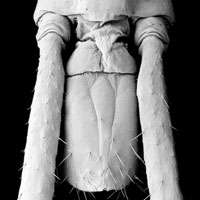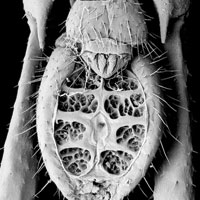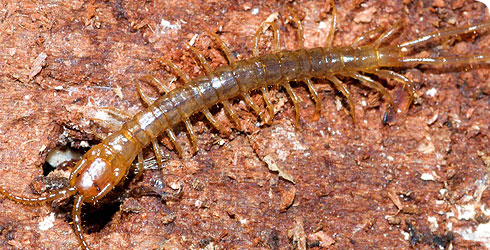Taxonomy
Morphology
Craterostigmus is distinguished from all other centipedes by:
- 15 leg-bearing trunk segments covered by 21 tergites (segments 3, 5, 7, 8, 10 and 12 each have 2 tergites)
- antenna with 17–18 articles, strongly attenuated distally
- a single ocellus on each side of the head - the ocellus has a remarkably complex ultrastructure, including several cellular details that are unique for centipedes as a whole (Müller and Meyer-Rochow, 2006)
- labrum with five teeth in midpiece and inner edge of sidepieces
- first maxillary telopodite a single undivided article
- anterior margin of the maxillipede coxosternite with a pair of serrate tooth plates, trochanteroprefemur of telopodite bearing a similar serrate process

Craterostigmus tasmanianus, showing the pair of 'can opener' tooth plates on the maxillipede coxosternite. These are the same in C. crabilli, which has 5–8 teeth on each plate. © Sue Lindsay, Australian Museum
- spiracles on trunk segments 3, 5, 8, 10, 12, and 14 - more than 1,500 tracheae per spiracle, tracheae unbranched
- pleural glands open on six trunk segments bearing long tergites (Dohle, 1990)
- trochanter of leg 15 (and variably legs 13 and 14 in C. tasmanianus) bearing a single strong ventral spine
- last leg-bearing segment with all sclerites merged as an undivided ring
- anal region developed as a bivalved capsule that opens ventrally, each side bearing four anal pore fields separated by cuticular bars
- ultimate leg elongate, slender

Craterostigmus crabilli in dorsal view, showing the basal parts of the 15th leg pair. The elongate structure projecting behind the ultimate leg-bearing segment is the anal capsule. This specimen comes from Dunedin, South Island.

Craterostigmus crabilli in ventral view, showing the anal capsule opened to reveal 8 fields (4 on each side) of pores that are openings of the anal glands.

Enlargement of the openings of the anal glands in Craterostigmus crabilli. The depression is the central part of the anal capsule is the anus (Rosenberg et al, 2006).
- male gonopod a small, elliptical flap
Diagnostic description
It is difficult to distinguish Craterostigmus crabilli from its closest relative Craterostigmus tasmanianus using morphological characteristics alone.
The two species can be separated based on molecular characteristics, or using a combination of external and internal anatomical characters:
- body length - up to 37mm in C. crabilli , compared to 50 mm or more in C tasmanianus
- ventral spine on trochanter of leg 14 are short and thorn-like or absent in C crabilli - in C tasmanianus they are often strong
- leg 14 lacks spines apart from on trochanter in C. crabilli - whereas C. tasmanianus sometimes has a spine on the coxa and prefemur
- leg 13 lacks spines in C. crabilli - sometimes C. tasmanianus has a spine on the trochanter and prefemur
- C. crabilli has 2 anteriorly oriented dorsal and ventral Malpighian tubules, whereas they are oriented in opposite directions in C. tasmanianus (Prunescu and Prunescu, 2006)
-

Evolution
Find out about the evolutionary history of Craterostigmus crabilli.
Toolbox
Glossary
Coxosternite
Plate at the base of the maxillipedes, composed of the fused coxa (the basal leg segment) and sternum.
Epimorphic
Same number of body segments at different stages of lifecycle.
Gonopod
A modified pair of legs that functions as an external reproductive organ.
Labrum
Lip that originates at the border of the mouth in arthropod development.
Malpighian tubules
Tubes used for excretion.
Maxillary telopodite
The outer, segmented part of the first pair of mouth appendages immediately behind the mandibles (jaws).
Maxillipede
Modified anterior pair of trunk legs that are a functional part of the head.
Ocellus
Eye structure.
Sclerites
Hardened plate like body parts.
Sternite
Plates on ventral surface.
Tergites
Plates along the back.
Trochanter
Second segment of a leg, between the coxa and the prefemur.
